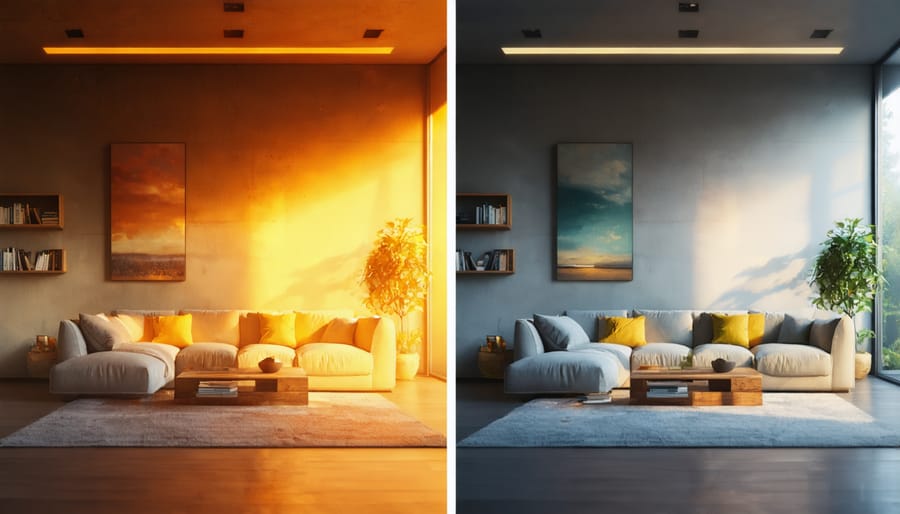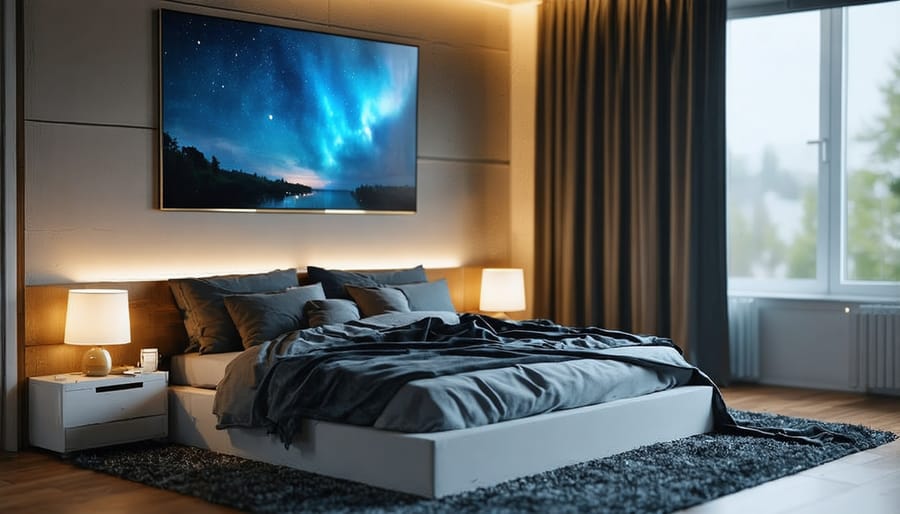Transform your living space into a natural wellness sanctuary with strategic lighting that enhances both mental and physical well-being. Smart LED bulbs that shift from energizing blue-white light during the day to calming amber tones at night naturally regulate your circadian rhythm and boost productivity. Install motion-activated dimming systems in bedrooms and bathrooms to maintain healthy sleep patterns with gentle illumination during nighttime activities. Position desktop lamps at a 45-degree angle from your workspace, combining natural daylight with adjustable artificial lighting to reduce eye strain and enhance focus.
The science is clear: proper lighting directly impacts our mood, sleep quality, and overall health. Today’s wellness lighting solutions merge cutting-edge technology with our body’s natural responses to light, creating environments that adapt to our daily needs. From color-changing bulbs that match our circadian rhythms to automated systems that adjust based on natural light levels, these innovations make it easier than ever to optimize our homes for better health and well-being.
How Lighting Shapes Your Well-being
The Science Behind Light and Mood
Light plays a fascinating role in regulating our body’s natural rhythms and emotional well-being. When light enters our eyes, it triggers the production of important hormones like serotonin and melatonin, which help control our mood and sleep patterns. During daylight hours, exposure to bright, blue-tinted light boosts serotonin, helping us feel energized and positive. As evening approaches, our bodies naturally respond to warmer, dimmer light by producing melatonin, preparing us for rest.
Research has shown that consistent exposure to the wrong type of light at the wrong time can disrupt these natural processes. For example, bright blue light in the evening can suppress melatonin production, making it harder to fall asleep. Conversely, insufficient bright light during the day can lead to feelings of lethargy and even seasonal affective disorder (SAD).
Understanding this science helps us make better lighting choices. By aligning our home lighting with our body’s natural rhythms, we can support better sleep, enhance our mood, and improve our overall well-being. This is where smart lighting solutions come in, allowing us to adjust both brightness and color temperature throughout the day to match our body’s needs.
Natural vs. Artificial Light
Natural light, with its dynamic qualities and full-spectrum illumination, remains unmatched in promoting wellness and aligning with biophilic design principles. It naturally regulates our circadian rhythm, boosts vitamin D production, and enhances mood. However, most of us can’t rely solely on sunlight, especially during darker months or in spaces with limited windows.
Modern artificial lighting has evolved to better mimic natural light’s benefits. Smart LED systems can now adjust their color temperature throughout the day, transitioning from energizing cool light in the morning to calming warm tones in the evening. While traditional artificial lighting often provides static, harsh illumination that can disrupt our natural rhythms, today’s wellness-focused options offer more nuanced solutions.
The key is finding the right balance. Maximize natural light where possible through strategic window treatments and reflective surfaces. Then supplement with artificial lighting that complements rather than competes with natural light. Consider using tunable LEDs near workspaces and relaxation areas, while keeping traditional warm lighting for ambient evening use.
Smart Lighting Technologies for Better Living
Color Temperature Control
Just as the sun’s light changes throughout the day, modern wellness lighting can adjust its color temperature to match our natural circadian rhythms. Color temperature, measured in Kelvin (K), ranges from warm amber tones (2700K) that mimic sunrise and sunset, to bright, cool whites (5000K+) that replicate midday sunlight.
In the morning, your lighting can gradually shift from soft amber to energizing cool white, helping to boost alertness and productivity. As evening approaches, the lights automatically transition to warmer tones, preparing your body for rest by supporting natural melatonin production.
Smart lighting systems make this process effortless through pre-programmed schedules or manual adjustments via smartphone apps. Many systems even sync with your local sunrise and sunset times, ensuring your indoor lighting perfectly complements the natural light patterns outside.
For optimal wellness benefits, aim for warmer colors (2700K-3000K) in spaces where you unwind, like bedrooms and living rooms. Use cooler temperatures (4000K-5000K) in task-oriented areas such as home offices and kitchens during daylight hours. Remember to gradually dim and warm the light as evening approaches, creating a gentle transition that helps signal to your body that it’s time to wind down.
This natural light matching doesn’t just look good – it helps maintain healthy sleep-wake cycles and can improve overall well-being.

Automated Scheduling
Setting up automated lighting schedules is one of the most effective ways to support your body’s natural circadian rhythm. Think of it as programming your lights to mimic the sun’s natural patterns, helping your body maintain its internal clock even when you’re spending most of your time indoors.
Start by mapping out your daily routine. Most smart lighting systems allow you to create multiple schedules for different times and days. In the morning, program your lights to gradually brighten between 6:00-7:00 AM, using cooler, bluish tones that help boost alertness. This gentle wake-up call is far more natural than a jarring alarm clock.
Throughout the day, maintain bright, cool lighting that keeps you energized and focused. As evening approaches, set your lights to automatically transition to warmer, dimmer tones starting around 6:00 PM. By 8:00 PM, your lighting should be significantly warmer and softer, helping your body prepare for sleep.
Many smart lighting systems offer preset circadian schedules that you can customize to your lifestyle. Look for features like vacation mode, which simulates occupancy while you’re away, and sunset/sunrise tracking that automatically adjusts to seasonal changes.
Pro tip: Create different schedules for weekdays and weekends, and don’t forget to include motion sensors for nighttime bathroom visits – use dim, warm lights that won’t disrupt your sleep cycle.
Light Intensity Management
Managing light intensity throughout the day is crucial for maintaining your body’s natural circadian rhythm and overall well-being. Start your morning with bright, energizing light (around 2000-3000 lumens) to help you wake up naturally and feel more alert. Consider installing dimmer switches or smart bulbs that can be programmed to gradually increase brightness, mimicking a natural sunrise.
During mid-day, aim for moderate to bright lighting (3000-4000 lumens) to maintain productivity and focus. If you’re working from home, position yourself near natural light sources and supplement with task lighting as needed. Remember to adjust your lighting based on the season and available daylight.
As evening approaches, begin reducing light intensity to prepare your body for rest. Around 2-3 hours before bedtime, lower brightness levels to 800-1500 lumens and shift to warmer color temperatures. Smart lighting systems make this transition effortless through automated scheduling.
For optimal control, consider these practical tips:
– Install motion sensors in low-traffic areas to manage brightness automatically
– Use task lighting for specific activities rather than flooding entire rooms with bright light
– Layer your lighting with a mix of ambient, task, and accent lights
– Take advantage of natural light whenever possible
– Keep a lighting schedule that aligns with your daily routine
Remember that individual comfort levels vary, so experiment with different intensities until you find what works best for you.
Room-by-Room Wellness Lighting Solutions
Bedroom Lighting for Better Sleep
Your bedroom’s lighting plays a crucial role in creating a calming environment that promotes quality sleep. The key is to work with your body’s natural circadian rhythm by adjusting light levels throughout the day.
Start with layered lighting options: install a dimmer switch for your overhead light, add bedside lamps with warm-toned bulbs (2700K-3000K), and consider LED strip lights behind your headboard for ambient lighting. Smart bulbs can be particularly helpful, allowing you to program gradual brightness changes that mirror natural sunset and sunrise patterns.
During the evening, begin dimming lights 2-3 hours before bedtime. This signals to your body that it’s time to produce melatonin, the sleep hormone. Opt for warm, amber-toned lights rather than cool, blue-tinted ones, which can suppress melatonin production.
For middle-of-the-night bathroom visits, install motion-sensor night lights that emit a soft, warm glow. This prevents the shock of bright light that can disrupt your sleep cycle. During the day, maximize natural light exposure by keeping window treatments open, which helps maintain healthy sleep-wake patterns.
Remember to keep electronic devices with bright screens away from your bedside, or use blue light filters in the evening. With these lighting strategies, you’ll create an environment that naturally supports restful sleep and morning alertness.

Home Office Lighting for Productivity
Creating the perfect lighting for your home office is crucial for maintaining productivity and reducing eye strain during long work hours. When combined with an ergonomic home office setup, proper lighting can transform your workspace into a focus-friendly environment.
Start with positioning your desk to maximize natural daylight, ideally perpendicular to windows to minimize glare. Layer your lighting with these three essential elements: ambient lighting for overall illumination, task lighting for focused work, and accent lighting to reduce contrast and eye fatigue.
For your main overhead light, opt for LED fixtures with color temperatures between 4000K and 5000K, which mimic natural daylight and help maintain alertness. Position your desk lamp on the opposite side of your writing hand to prevent shadows, and choose one with adjustable brightness levels and color temperature settings.
Consider installing smart bulbs that can automatically adjust throughout the day, following your natural circadian rhythm. Program warmer tones (2700K-3000K) for early morning and late afternoon work sessions, and cooler tones for peak productivity hours.
Don’t forget about glare reduction on your computer screen. Position your monitor at a slight downward angle and use indirect lighting to minimize reflections. If possible, install dimmer switches to fine-tune your lighting throughout the day as natural light changes.

Living Areas and Social Spaces
Living spaces are where we connect, relax, and recharge, making proper lighting essential for both functionality and mood. Start with layered lighting that combines ambient, task, and accent elements to create a versatile environment that adapts to different activities and times of day.
For your main living room, install dimmable overhead fixtures or recessed lighting to provide adjustable ambient light. Complement these with wall sconces or floor lamps positioned near seating areas, creating intimate zones perfect for conversation or reading. Consider adding LED strip lighting behind entertainment centers or shelving units for a subtle glow that reduces eye strain during movie nights.
In dining areas, pendant lights or chandeliers should hang 30-36 inches above the table, providing focused illumination that encourages social interaction without casting harsh shadows on faces. Install dimmer switches to transition smoothly from bright family dinners to intimate evening meals.
Create conversation corners by placing table lamps at eye level when seated, roughly 58-64 inches from the floor. This height provides optimal lighting for face-to-face interactions while maintaining a cozy atmosphere. Smart bulbs can be particularly effective here, allowing you to adjust color temperature from energetic cool whites during daytime gatherings to warm, relaxing tones for evening social events.
Remember to incorporate natural light by keeping windows unobstructed during the day and using light, translucent window treatments that filter harsh glare while maintaining brightness. This connection to natural light helps maintain healthy circadian rhythms while creating an inviting atmosphere for social gatherings.
Getting Started with Wellness Lighting
Starting your wellness lighting journey doesn’t have to be overwhelming. Begin with a single room where you spend the most time, like your bedroom or home office. Smart bulbs are an excellent entry point – brands like Philips Hue and LIFX offer easy-to-install options that connect to your smartphone, allowing you to adjust brightness and color temperature throughout the day.
For optimal results, create a lighting schedule that mirrors natural daylight patterns. Program your lights to emit energizing cool white light (around 5000K) in the morning, transitioning to warmer tones (2700K) as evening approaches. Many smart lighting systems offer preset schedules you can customize to your routine.
Consider layering your lighting with these essential elements:
– Ambient lighting: Install dimmable overhead fixtures or smart recessed lights
– Task lighting: Add adjustable desk lamps or under-cabinet lights
– Accent lighting: Include subtle strips or small fixtures to reduce harsh shadows
Don’t forget about natural light integration. Position mirrors strategically to reflect daylight, and use smart blinds or shades that work in harmony with your lighting system. Start with one or two key pieces and gradually expand your setup as you become more comfortable with the technology.
For those on a budget, even simple dimmer switches and LED bulbs with adjustable color temperatures can make a significant difference in creating a wellness-focused lighting environment.
Transforming your living space with wellness lighting is more than just a trend – it’s an investment in your daily comfort and well-being. By implementing the strategies we’ve discussed, from choosing the right color temperatures to incorporating smart lighting systems, you can create an environment that supports your natural rhythms and enhances your quality of life. Start small by upgrading one room at a time, perhaps beginning with your bedroom or home office where lighting has the most immediate impact on your daily routine. Remember that wellness lighting isn’t just about brightness – it’s about creating the right atmosphere at the right time. Take the first step today by assessing your current lighting setup and identifying areas where improvements could make the biggest difference in your daily life. Your future self will thank you for creating a more harmonious, healthy living space through thoughtful lighting choices.
